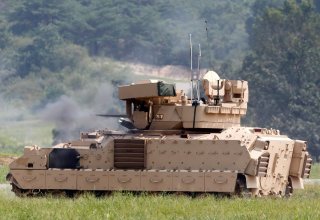U.S. Army Bradley Fighting Vehicles and Robots Are Waging War Together
The future of war is already here: U.S. Army soldiers operating modified Bradley Fighting Vehicles acquired enemy targets by operating combat drones armed with guns and sensors, as part of an exercise intended to refine unmanned systems for targeting and attack operations.
U.S. Army soldiers operating modified Bradley Fighting Vehicles acquired enemy targets by operating combat drones armed with guns and sensors, as part of an exercise intended to refine unmanned systems for targeting and attack operations.
The modified Bradleys, called Mission Enabling Technologies-Demonstrators (MET-Ds), controlled several Robotic Combat Vehicles up to a 2,000 meter range, an Army report said.
These new MET-Ds have 360-degree cameras, a 25-mm main gun, and control touchscreens. “The RCVs are M113 surrogate platforms that also have 360 cameras and fire 7.62 mm machine guns,” the Army report stated.
“The ability [to spot enemies] was exceptional, because that reduces the risk on our Soldiers and allows us to remain in a covered and concealed position and make decisions,” Coffman said during a media conference call Thursday. Brigadier General Richard Coffman, director of the Next-Generation Combat Vehicle Cross-Functional Team, said in the Army statement.
The concept is clear—enable human soldier decision makers operating in a command and control capacity to receive organized, fused and integrated combat data in real time from robots. Unmanned vehicles could carry ammunition, cross bridges into enemy fire, perform forward recon missions to test enemy defenses, coordinate with air attack assets and—when directed by human authorities—destroy enemy targets with mounted weapons.
Not only will these kinds of technical steps expand attack options and combat lethality while better protecting soldiers from enemy fire, but they also help expand the battlefield to expedite air-ground networking and longer-range operations.
The unmanned vehicles could also accompany dismounted soldiers on patrol as a way to reinforce their mission without placing manned crews in danger of enemy fire. The robot vehicles could call for fire, carry supplies and ammunition, surveil forward terrain, provide targeting data or, if called upon by a human operator, potentially fire weapons.
It’s the cutting-edge of manned-unmanned teaming, human-machine interface coordinating human decision-makers with robots increasingly able to perform autonomous functions. Moreover, the Army doctrinal parameters are significant because the technological ability of a robot to surveil, track, target and destroy a target without human intervention is basically here.
However, for ethical and tactical reasons, military maintains its clear position that humans must make decisions regarding the use of lethal force, despite advances in algorithms enabling greater autonomy. The doctrinal stance is also grounded in a recognition that even the most advanced computer algorithms are not sufficient to replace the problem-solving and decision-making abilities of human cognition. There is concern, however, that potential adversaries will not adhere to similar doctrine.
Kris Osborn is defense editor for the National Interest. Osborn previously served at the Pentagon as a Highly Qualified Expert with the Office of the Assistant Secretary of the Army—Acquisition, Logistics & Technology. Osborn has also worked as an anchor and on-air military specialist at national TV networks. He has appeared as a guest military expert on Fox News, MSNBC, The Military Channel, and The History Channel. He also has a Masters Degree in Comparative Literature from Columbia University.
Image: Reuters

